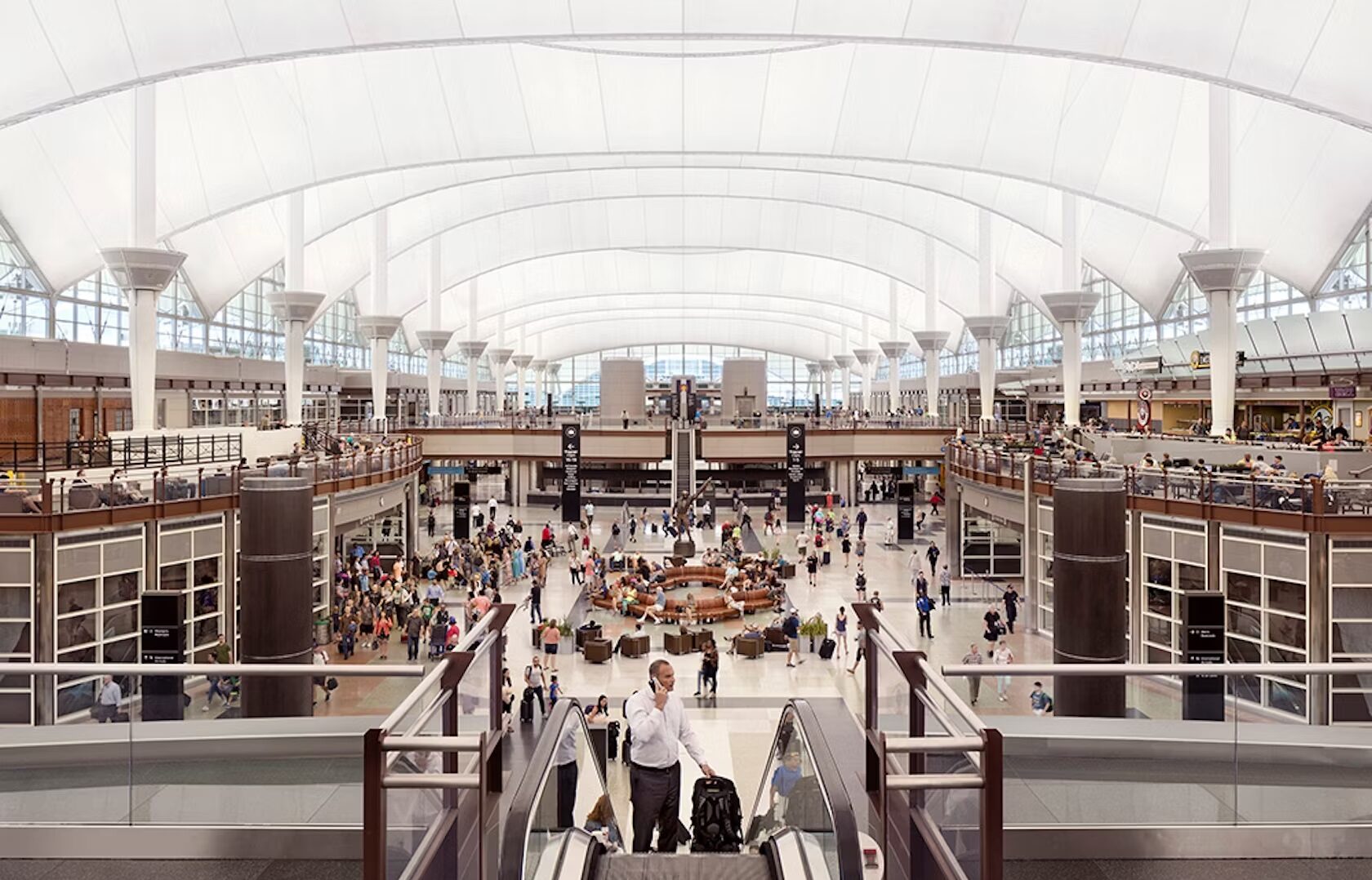Made to Fly: 6 Airport Terminals Taking Design to New Heights
Architects: Want to have your project featured? Showcase your work through Architizer and sign up for our inspirational newsletters.
Travel brings people together. In turn, the spaces we occupy when we travel shape our journey and moments of connection. Often one of the most polarizing types of architecture, airports are at their best when they create spaces of comfort and, at times, delight. Airport structures and buildings have grown and changed alongside advancements in aviation. With new programs and amenity spaces, from expansive retail and dining to luxurious lounges, terminal design is constantly being reimagined around the world.
In architecture, terminal design is still fairly new. With airports only emerging in the last century, larger airfields and runways also came with larger terminals or multiple terminals connecting together at a single airport. Today, architects approach terminal design through the lens of security and efficiency, but they are also inspired by surrounding contexts and the act of flying itself. Exploring this fascination with the ocean above us, the following projects illustrate terminal design in airports big and small. They are totally unique projects that give a glimpse into what it means to fly today and the spaces where people are brought together.
Venice Marco Polo Airport: Terminal Refurbishment and Extension
One Works, Venice, Italy

 Designed as a gateway project for Venice and a landmark terminal, this renovation and expansion project was also complete alongside the Marco Polo airport masterplan by One Works. To accommodate growth for the airline’s service, the VCE terminal was made to extend capacity to 15 million passengers a year. At the same time, the project needed to respect the historic fabric of Venice and the city’s fragile lagoon ecosystem.
Designed as a gateway project for Venice and a landmark terminal, this renovation and expansion project was also complete alongside the Marco Polo airport masterplan by One Works. To accommodate growth for the airline’s service, the VCE terminal was made to extend capacity to 15 million passengers a year. At the same time, the project needed to respect the historic fabric of Venice and the city’s fragile lagoon ecosystem.
The first phase of the expansion project was complete in 2017. The scope included work on both the airside and landside of the airport, as well as two new wings built for the front terminal. The structure was designed with an intricate glass roof form that reinterprets Venetian docks. It was made to connect the areas receiving departing and arriving passengers, while also recalling the rich traditions of Venetian glass blowing.
Nanning Airport
Kohn Pedersen Fox Associates, Nanning, China

 KPF approached the design for the new Nanning Wuxu airport within a larger plan for growth and expansion of the terminal system. The international airport is located in the capital of the Guanxi Region of China, with a building form inspired by hills in the surrounding mountain range. KPF took on the challenge of developing the masterplan while also allowing for connection to the trains that can bring passengers to the airport.
KPF approached the design for the new Nanning Wuxu airport within a larger plan for growth and expansion of the terminal system. The international airport is located in the capital of the Guanxi Region of China, with a building form inspired by hills in the surrounding mountain range. KPF took on the challenge of developing the masterplan while also allowing for connection to the trains that can bring passengers to the airport.
The result is a sinuous, two million square foot terminal building with an ovoid shallow dome at its heart. This central area not only marks the arrival and departure hall, but also becomes a kind of urban room that first introduces travelers to the city and the airport. This “great room” is capped by an innovative roof canopy, a design that aimed to reinterpret airplane wings and bird wings alike. Today, the Nanning Wuxu airport sets the tone for the city and its future.
Keflavik Airport Extension
Andersen & Sigurdsson Architects, Reykjanesbær, Iceland

 As a light, airy addition to Keflavik Airport, this terminal was made by Andersen & Sigurdsson Architects in Reykjanesbær. After Eyjafjallajökull volcano erupted in Iceland back in 2010, the country feared it would impact travel. Instead, travelers from around the world flooded into Iceland, and in turn, there was a need to expand Keflavik airport once again. The new terminal the team designed the expansion to accommodate a system where passengers move to and from the aircrafts by remote stands.
As a light, airy addition to Keflavik Airport, this terminal was made by Andersen & Sigurdsson Architects in Reykjanesbær. After Eyjafjallajökull volcano erupted in Iceland back in 2010, the country feared it would impact travel. Instead, travelers from around the world flooded into Iceland, and in turn, there was a need to expand Keflavik airport once again. The new terminal the team designed the expansion to accommodate a system where passengers move to and from the aircrafts by remote stands.
Built to organize flow for both Schengen and non-Schengen passengers, the terminal expansion focuses on simplicity and a rational design. It was built with a straightforward steel frame, a continuous glass façade, and prefabricated concrete slabs. As the team explained, the materials and colors were inspired by nature and Iceland’s incredible environments. The expansive facade also means that travelers can see Iceland’s changing weather and vast landscapes from the airport itself.
Denver International Airport Passenger Terminal
Fentress Architects, Denver, Colorado

 Few airports and terminals are as recognizable as Denver International. As the architecture team outlines, when the Passenger Terminal opened in 1995, it represented a major shift in airport design where airports were now understood as gateway projects. All of the mechanical systems are housed underground, while the world’s largest, structurally integrated, Teflon-coated tensile-membrane structure topped the airport.
Few airports and terminals are as recognizable as Denver International. As the architecture team outlines, when the Passenger Terminal opened in 1995, it represented a major shift in airport design where airports were now understood as gateway projects. All of the mechanical systems are housed underground, while the world’s largest, structurally integrated, Teflon-coated tensile-membrane structure topped the airport.
As the fifth busiest airport in the United States, Denver International has become a true travel hub and a well-known landmark. The peaked roof forms are now symbolic of Denver, Colorado, and the local context. Recalling snowcapped mountains and inspired by patterns and materials native to the Rocky Mountain region, the iconic roof rises to 150 feet at its highest point. Clerestory windows combine with glass skylights that punctuate the fabric roof’s mast tops to further bring in natural light alongside the diffuse light through the fabric.
St. Louis-Lambert International Airport Main Terminal Renovation
exp, Saint Louis, Missouri

 EXP led the renovation and transformation of Minoru Yamasaki’s iconic Terminal 1 in St. Louis, a mid-century masterpiece. Aiming to return the terminal to its original grandeur, the team wanted to respect the existing structure while modernizing it. As part of the airport’s “Experience” program, the Gateway to St. Louis would be complete in three phases. The renovation reopens the project’s soaring vaults to restore the project’s core idea of a gallery-like waiting areas with open views in and out to a sculpture court.
EXP led the renovation and transformation of Minoru Yamasaki’s iconic Terminal 1 in St. Louis, a mid-century masterpiece. Aiming to return the terminal to its original grandeur, the team wanted to respect the existing structure while modernizing it. As part of the airport’s “Experience” program, the Gateway to St. Louis would be complete in three phases. The renovation reopens the project’s soaring vaults to restore the project’s core idea of a gallery-like waiting areas with open views in and out to a sculpture court.
The full scope for the airport terminal included renovation and restoration of the terminal vaults and skylights, as well the renovation of the remainder of Terminal 1’s ticketing counters, lighting, and HVAC. EXP’s work included the restoration of the concrete vaults and replacement of curtain-wall glazing. Beyond that, they took on the design of ticketing, concourses, concessions, lighting/MEP as well as security checkpoints.
Helsinki Airport Departures and Arrivals Building
ALA Architects, Vantaa, Finland

 Helsinki is home to a beautiful new airport terminal in Vantaa, Finland. The overall design concept plays with the idea of lightness, drawing views up while bringing in natural light. The new departures and arrivals building was made with two volumes. As the team explained, the first one defined by “its wooden ceiling, the second by its blue color.” At the same time, steel structures allowed for an expansive entrance canopy and a column-free departures hall.
Helsinki is home to a beautiful new airport terminal in Vantaa, Finland. The overall design concept plays with the idea of lightness, drawing views up while bringing in natural light. The new departures and arrivals building was made with two volumes. As the team explained, the first one defined by “its wooden ceiling, the second by its blue color.” At the same time, steel structures allowed for an expansive entrance canopy and a column-free departures hall.
The structure and ceiling seems to float in the air; the structural ideas at play in the terminal building are thanks to prefabricated timber units. “Just like the sight of a jumbo jet taking off, it defies common sense,” the design team noes. After passing through customs, travelers are greeted by the “Luoto” nature diorama, a freeform installation with trees, shrubs and stones. The idea was to pay homage to Finnish nature and create a nod to Japanese garden art.
Architects: Want to have your project featured? Showcase your work through Architizer and sign up for our inspirational newsletters.


